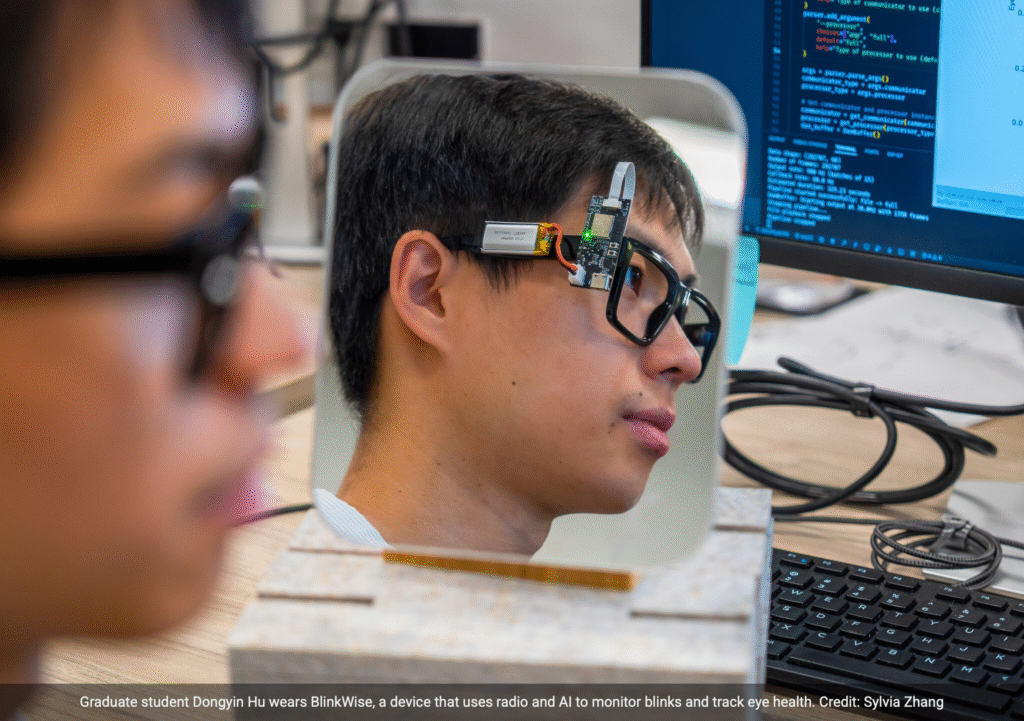AI at the Eyelid: Smart Glasses That Track Health Through Your Blinks

Researchers at the University of Pennsylvania have introduced a breakthrough in wearable technology: BlinkWise, a device that transforms ordinary glasses into intelligent health monitors. By using artificial intelligence and low-power radio signals, BlinkWise can analyze eyelid movements in real time, offering new possibilities for detecting fatigue, eye diseases, and even cognitive changes.
This innovation reflects a growing shift in medical research toward non-invasive, continuous health monitoring—tools that can fit seamlessly into daily life while capturing meaningful physiological data.
The Power of a Blink
The average person blinks more than 10,000 times each day. While often taken for granted, each blink carries valuable information. Beyond lubricating the eye, blinks reveal clues about fatigue, attention span, and ocular health.
Researchers highlight the concept of blink dynamics—the fine details of how we blink. These include:
- Blink duration – how long the eyelids stay closed.
- Completeness – whether the blink fully closes the eyelid or only partially.
- Timing patterns – how frequently and rhythmically blinks occur.
For example, longer eyelid closures can signal drowsiness, a leading contributor to car accidents and workplace errors. A rise in partial blinks may point to dry-eye disease, a chronic condition that affects more than 16 million Americans. Changes in blink patterns may also reflect mental workload or early signs of cognitive decline.
As ophthalmologist Lama Al-Aswad explains, “Blinking is something we do thousands of times per day without thinking, and yet it reflects so much about our health. Because it’s noninvasive and easy to monitor, blink analysis could become a powerful tool for managing chronic conditions and identifying cognitive changes early.”
Why BlinkWise Is Different
Traditional methods of studying blink dynamics have relied on high-speed cameras and controlled laboratory settings. These setups provide detailed data, but they are expensive, bulky, and impractical for everyday use.
BlinkWise changes this equation. Instead of capturing images, the device uses radio waves that bounce off the eyelid to detect minute movements. The reflected signals are converted into an “eye openness score,” a curve that models blinking in real time with millisecond-level accuracy.
This approach provides far more detail than conventional cameras, which typically record at 30–60 frames per second. By comparison, BlinkWise can sample thousands of times per second, capturing the subtle changes of each blink with remarkable precision.
AI That Fits on Your Face
A central challenge for the research team was making BlinkWise not only accurate, but also wearable. Advanced AI normally requires significant computing power and energy, which could drain batteries quickly. To overcome this, the researchers designed a miniaturized AI system that processes data locally on a chip no larger than a postage stamp.
Unlike many wearable technologies that depend on cloud computing or smartphones, BlinkWise performs all calculations on the glasses themselves. This means less energy consumption, more privacy for users, and smoother real-time feedback.
As project lead Mingmin Zhao explains, “Because BlinkWise brings together low-power radio-wave sensing and edge AI, it can sense more efficiently and run advanced health monitoring directly on the glasses with less energy, less space, and less data than existing smart eyewear.”
Applications and Future Potential
At present, the most immediate applications of BlinkWise include:
- Fatigue detection in transportation and workplace safety.
- Monitoring dry-eye disease and related ocular conditions.
- Assessing mental workload in high-stress professions such as aviation or medicine.
But the team believes this is just the beginning. Smart glasses that “understand” the wearer through blink patterns could form the foundation for a new generation of intelligent eyewear—devices that respond not only to voice commands, but also to the user’s physiological and cognitive states.
Graduate student Dongyin Hu, who helped lead the study, summarized it this way: “We see BlinkWise not just as a health monitor, but as a building block for glasses that are truly intelligent.”
Conclusion
BlinkWise demonstrates how AI-driven, non-invasive monitoring can open a new frontier in healthcare. By analyzing something as simple as a blink, researchers can gain insights into fatigue, eye health, and brain function—while preserving privacy and portability.
While still in its early stages, BlinkWise may pave the way for smart glasses that are not only gadgets, but partners in health and safety. For eye care professionals and patients alike, this represents an exciting glimpse into the future of ocular health technology.
This article is based on original reporting by University of Pennsylvania researchers, published via Medical Xpress.
